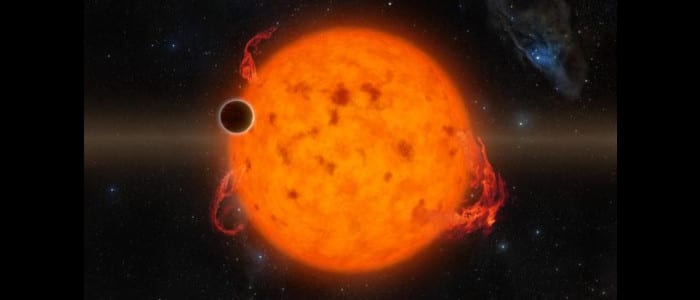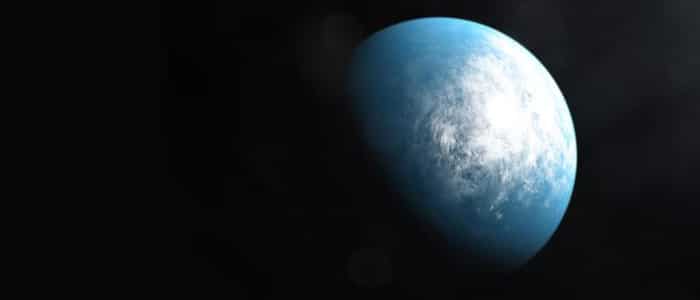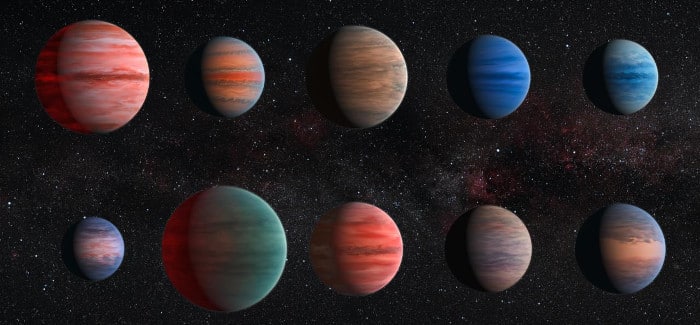There are four different types of Exoplanets. They are categorized into Gas Giants, Super Earths, Neptunian, and Terrestrial planets. As you can probably intuit from the category names, the classifications have a lot to do with their size and or composition. But we will get into each category below.
Gas Giants
These Exoplanets are called Gas Giants because, for one, they are the size of Saturn, Jupiter, or even more significant. They have a composition of hydrogen and or helium and therefore do not have a solid surface. Instead, they have clouds of gases atop their core. These planets orbit their parent stars so tightly that some can make a full orbital rotation in eighteen hours.
In 1995, the first planet discovered around a star similar to the Sun was 51 Peg b. This and similar planets are believed to form inside the first ten million years of the parent star’s life. These planets are also known as Hot Jupiters because their temperatures are upwards of thousands of degrees due to their proximity to their parent stars. The hottest Gas Giant ever found is Kelt-9b, hotter than most other stars. We may explore Kelt-9b on its own and in-depth at a later time.

Super-Earths
The Super Earths are terrestrial planets that are bigger than Earth by mass while also being slighter than Neptune. They can be anywhere from three to ten times that of Earth. Some of them can have atmospheres, but it is not required.
They are also sometimes described as mini Neptunes and can reach temperatures extreme enough to vaporize metal.
Kepler-425b was the first Exoplanet discovered that was both relative in size to Earth and had a near solar twin. And there is a possibility that Kepler-22b is covered in a super ocean, which means that it is larger than the Pacific Ocean

Neptunian
Neptunian Exoplanets are around the size of Neptune, which would be around four times the size and seventeen times the mass of Earth. These planets have hydrogen and helium-dominated atmospheres with heavy metals at their cores covered with rocky surfaces.
The first Neptunian Exoplanet, or ice giant, was discovered in 2014 and is 25,000 light years away from us. These Exoplanets most often have thick layers of cloud surrounding them, making it hard for us to get molecular signatures from them. It is expected that we will find out more now that the James Webb Telescope was launched in 2021.

Terrestrial
The size of Earth or smaller, these Extrasolar Planets are comprised of rock, iron, water, carbon, or silicates. They also may have an atmosphere and or water and may or may not be habitable. There may be upwards of ten billion Terrestrial Planets just in our galaxy alone.
Scientists believe the Trappist-1 System of Exoplanets to be Terrestrial and Super Earth-size. Kepler-11b is also a Terrestrial Planet that is ten times closer to its parent star than Earth is to the Sun.
NASA’s Kepler Space Telescope had initially shown that somewhere between twenty and fifty percent of all stars in the sky might have Terrestrial Planets in their habitable zones, but that estimate has since been corrected to between two and twelve percent.

I will investigate some of the Extrasolar Planets from each category in the days and weeks ahead. I hope that you will join me in the exploration.
If you want to do that, you can sign up for my newsletter and get notifications of new and exciting posts straight to your inbox.
The Wrap Up
Are you starting to get excited about what else could be out there beyond our solar system? I am too. As I stated above, I will get into some of the Exoplanets individually and more in-depth. But I will also be getting more specifically into ones that have a higher possibility of being habitable to humankind. I hope to see you there!
This post contains affiliate links. Learn more and read our full disclosure policy here.

If you have any questions about Astro Explorations or if you have any comments that you would like to share, feel free to leave them down below, and I will get back to you as soon as possible.
Disclosures & Policies
All Images Are Courtesy of NASA
References
NASA. (2022, April 13). What Is An Exoplanet. Retrieved from NASA: https://exoplanets.nasa.gov/what-is-an-exoplanet/planet-types/overview/


Great article Brandaley! I appreciate how you layout this information and the simplicity of the images that you used. Explaining the differentiation between these planets is not something easy to present but you were so clear and to the point. Likewise, always thinking if their Exoplanets could be considered as an alternative of our planet.
Best Regards,
Hello Neda,
Thank you for your kind words. I appreciate it. If you are interested, I will be doing some articles in the next few weeks on the Exoplanets that are the most likely to be able to sustain human life.
I hope to see you there.
Have a wonderful weekend!
You lost me when you mentioned that the first planet discovered around a star similar to the Sun was 51 Peg b. What is 51 Peg b? Is it the name of the the first planet? Sorry, but I am not familiar with the different types of exoplanets and names associated with them, so a list of names would be helpful, if there is a list.
So is 51 Peg b a Hot Jupiter? Or are Hot Jupiters different? I find this a very complex topic so any elaboration would be useful and appreciated.
Hello Line,
Sorry about that, 51 Peg b was the temporary name used for the Exoplanet Dimidium when it was discovered. And yes, there are lists, but it is extensive, with over 5,000 confirmed Exoplanets.
Yes, Dimidium (51 Peg b) is considered a “Hot Jupiter,” which is essentially a Gas Giant that orbits its own star in closer proximity than Mercury does to our sun. This, in turn, makes the temperatures extremely hot for these Exoplanets.
I hope this helps. And I hope to see you again. Until next time.
Have a wonderful day!
What a fantastic piece of writing! I like the clean presentation of this data and the clarity of the pictures you chose to accompany it. It’s not easy to present information like how these planets are unique from one another, yet you did it so well. To the same extent, they frequently wonder if one of these Exoplanets might one day replace Earth. Thank you for this amazing post
Hello Pasindu,
There is an entire community, well actually there are many, focusing on the possibilities of colonizing different Planets and Exoplanets because they believe that Earth will become inhabitable with time. And while I do not think it will happen any time soon, I am having a great time exploring the possibilities.
Have a wonderful day!
The components of these planets continue to amaze me. Their basic composition of gaseous substances and their large sizes. I cannot continue to wonder about the Super Earths, how they have size that are larger than the Earth and still do not support man’s existence. Top of it is how they also have atmospheres even when you said it is not needed
Hello Parameter,
I am continually amazed by what I am discovering as well. While an atmosphere is not a requirement to be classified as a Super-Earth, it is believed that only a Super-Earth is likely to have the ability to host human life. I guess only time will tell us if this is true.
I am happy to see you again.
Stay Safe & Have a Wonderful Holiday Season!